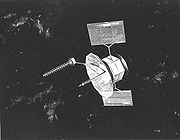
Fleet Satellite Communications System
Encyclopedia

Most of the transponders on these satellites are simple repeaters with no authentication or control over what they retransmit. This characteristic led to a subculture of radio pirates
Pirate radio
Pirate radio is illegal or unregulated radio transmission. The term is most commonly used to describe illegal broadcasting for entertainment or political purposes, but is also sometimes used for illegal two-way radio operation...
in Brazil using modified ham radio equipment making use of the satellites without authorization.
Altogether eight satellites were launched in the years from 1978 to 1989 by Atlas-Centaur
Atlas-Centaur
The Atlas-Centaur was an American expendable launch system designed and built by General Dynamics Convair Division in San Diego, CA. It was derived from the SM-65 Atlas missile. It was a member of the Atlas family of rockets, and was used for 61 orbital launches between 1962 and 1983. It was...
rockets into geostationary orbit
Geostationary orbit
A geostationary orbit is a geosynchronous orbit directly above the Earth's equator , with a period equal to the Earth's rotational period and an orbital eccentricity of approximately zero. An object in a geostationary orbit appears motionless, at a fixed position in the sky, to ground observers...
. The system became operational in 1981. The satellites were manufactured by TRW
TRW
TRW Inc. was an American corporation involved in a variety of businesses, mainly aerospace, automotive, and credit reporting. It was a pioneer in multiple fields including electronic components, integrated circuits, computers, software and systems engineering. TRW built many spacecraft,...
. The solar arrays of the satellites had a span of over 13.2 m. A special characteristic was an UHF transmit antenna reflector 4.9 m in diameter. The satellites had 12 transponders, which worked in the UHF range from 240 - 400 megahertz. Additionally FLTSATCOM 7 and 8 had an experimental EHF transponder built by Lincoln Laboratory intended to test the MILSTAR ground terminals. The first seven satellites had a launch mass of 1884 kg and the remaining two were 2310 kg, with the additional mass due to the EHF payload module.
The fifth satellite reached geosynchronous orbit, but was unusable due to damage to the solar arrays and antennas. The failure was attributed to explosive delamination of the fiberglass honeycomb fairing during flight. The inside wall of the fairing extensively damaged one of the solar arrays, and bent the transmit antenna mast which prevented the antenna from deploying fully.
Flight 7 was launched out of sequence after a launch failure of a Delta mission carrying the GOES-G weather satellite grounded the entire US launch fleet weeks prior to the scheduled launch of F-6. By the time the Delta mishap investigation concluded there was no risk to the Atlas-Centaur system, F-7 was ready to launch & the system managers elected to swap missions to avoid delaying EHF system testing.
Flight 6 was destroyed when a lightning strike caused a memory upset in the Atlas-Centaur guidance computer, causing the booster to veer off-course 51 sec into flight.
In the late 1990s FLTSATCOM satellites were gradually replaced by the UFO satellites
UHF Follow-On System
The Ultra High Frequency Follow-On System is a United States Department of Defense program sponsored and operated by the U.S. Navy to provide communications for airborne, ship, submarine and ground forces. The UFO constellation replaced the U.S. DOD Fleet Satellite Communications System ...
. FLTSAT flights 7 and 8 continue to provide UHF communications.
Launches
| Satellite | Launch | Rocket | Note |
|---|---|---|---|
| FLTSATCOM 1 | February 9, 1978 | Atlas-SLV3D Centaur-D1AR Atlas-Centaur The Atlas-Centaur was an American expendable launch system designed and built by General Dynamics Convair Division in San Diego, CA. It was derived from the SM-65 Atlas missile. It was a member of the Atlas family of rockets, and was used for 61 orbital launches between 1962 and 1983. It was... |
Success |
| FLTSATCOM 2 | May 4, 1979 | Atlas-SLV3D Centaur-D1AR | Success |
| FLTSATCOM 3 | January 18, 1980 | Atlas-SLV3D Centaur-D1AR | Success |
| FLTSATCOM 4 | 31. October 31, 1980 | Atlas-SLV3D Centaur-D1AR | Success |
| FLTSATCOM 5 | August 6, 1981 | Atlas-SLV3D Centaur-D1AR | Damaged upon launch |
| FLTSATCOM 7 | December 5, 1986 | Atlas-G Centaur-D1AR Atlas G The Atlas G, also known as Atlas G Centaur-D1AR was an American expendable launch system derived from the Atlas-Centaur. It was a member of the Atlas family of rockets, and was used to launch seven communication satellites during the mid to late 1980s... |
Success |
| FLTSATCOM 6 | March 27, 1987 | Atlas-G Centaur-D1AR | Lightning strike destroyed the rocket |
| FLTSATCOM 8 | September 25, 1989 | Atlas-G Centaur-D1AR | Success |

